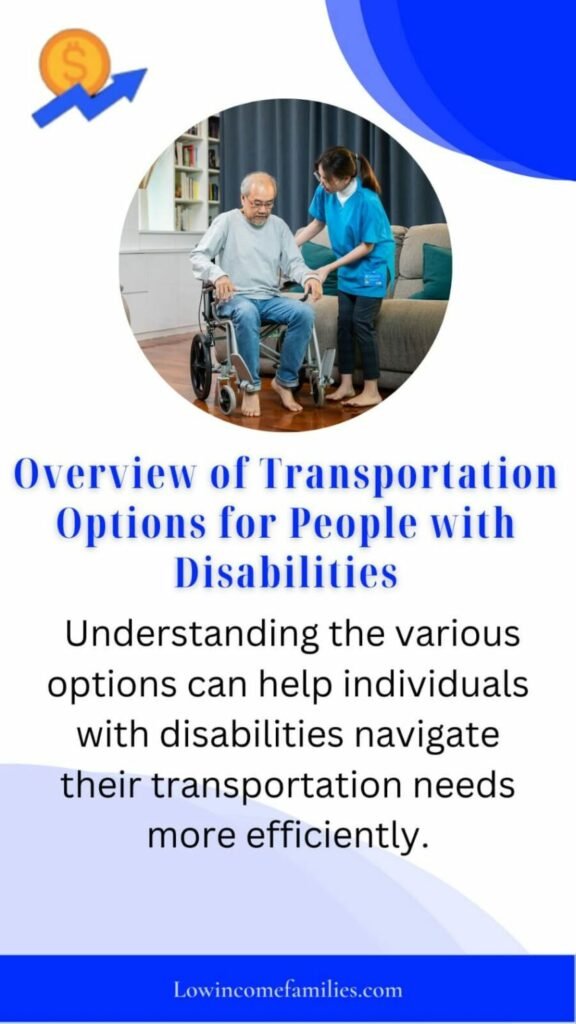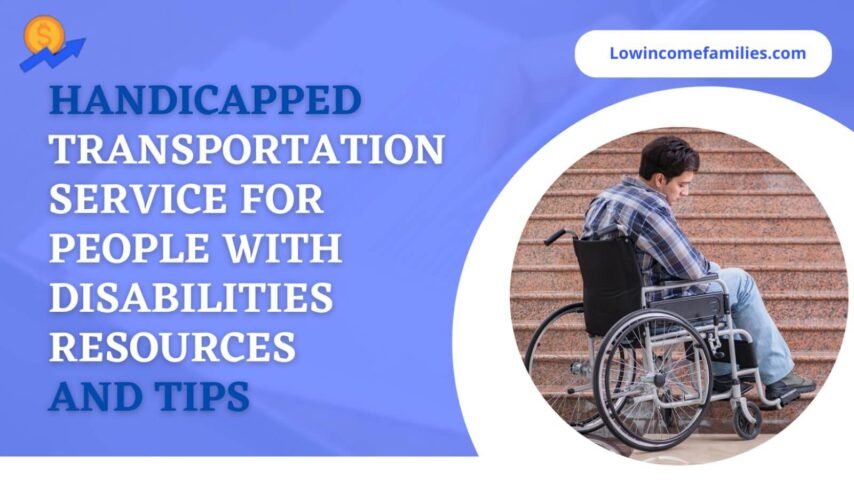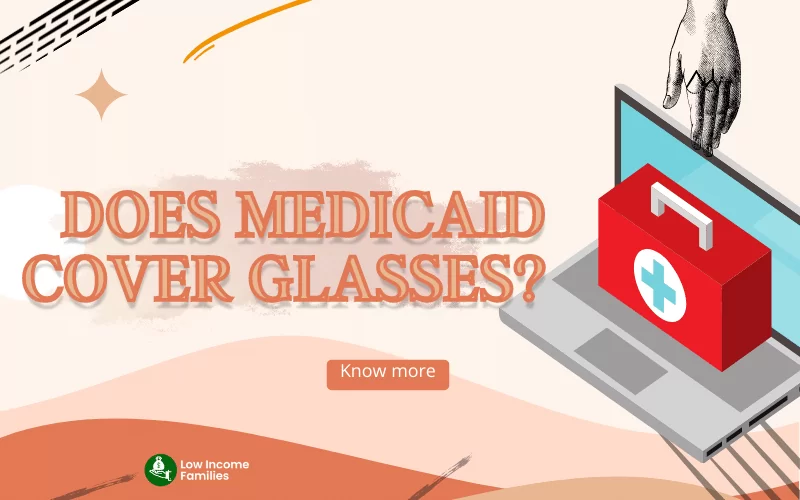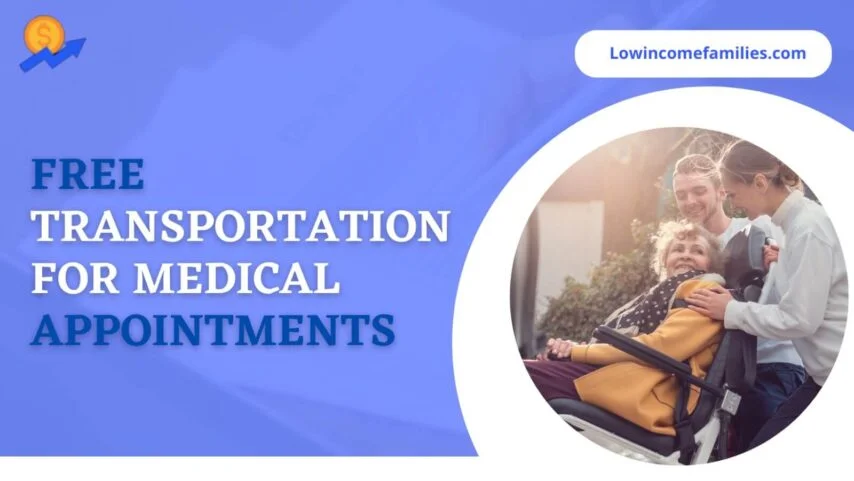Navigating Handicapped Transportation options can be a challenge for anyone, but for people with disabilities, it can be challenging. The lack of accessibility and accommodations can make getting from one place to another difficult, whether for work, school, or leisure.
Fortunately, there are many resources and tips available that can make the journey easier. This post discusses various available transportation options, including public transit, paratransit, and ride-sharing services.
We’ll also provide tips on planning for transportation, what to look for in transportation providers, and how to advocate for your rights as a person with a disability.
Whether you have a physical or cognitive disability, read on to learn how to navigate transportation options and get to your destination safely and comfortably.
Challenges Of Transportation For People With Disabilities
Transportation can be an everyday challenge for people with disabilities. The difficulties faced by those with disabilities can range from lack of access to transportation options to difficulty navigating public transportation systems.
These challenges can result in isolation, limited employment opportunities, and reduced access to healthcare services. People with disabilities often cannot travel independently, limiting their ability to participate in social activities, access education, and maintain a job.
Transportation barriers can also affect the mental and emotional well-being of individuals with disabilities, leading to anxiety, depression, and frustration.
For example, a simple task like running errands can be a significant challenge when public transportation is not accessible or does not accommodate their specific needs.
It’s important to recognize these challenges and work towards finding solutions to improve transportation options for people with disabilities.
This blog aims to provide resources and tips to help navigate transportation options and overcome challenges faced by people with disabilities. By doing so, we can help create a more inclusive and accessible society for all.
Get Medical Records Online Free
Overview Of Transportation Options For People With Disabilities
Transportation can be challenging for individuals with disabilities, but several options are available to meet their needs. Understanding the various options can help individuals with disabilities navigate their transportation needs more efficiently.

Here’s an overview of some of the transportation options available:-
-
Public Transportation
Many cities have public transportation services specifically designed for individuals with disabilities. These services may include wheelchair ramps, lifts, and tie-downs to secure wheelchairs during transportation. Public transportation can be a cost-effective and convenient option for individuals with disabilities and is environmentally friendly.
-
Paratransit Services
Paratransit services are specialized transportation services provided to individuals with disabilities who cannot use fixed-route public transportation. Public transit agencies often offer these services, including door-to-door transportation or curb-to-curb service.
-
Ride-Sharing Services
Ride-sharing services like Uber and Lyft have become increasingly popular in recent years and are available in many cities. Both services offer wheelchair-accessible vehicles; some even offer other accommodations such as trained drivers and assistance carrying luggage.
-
Non-Emergency Medical Transportation (NEMT)
NEMT is a specialized transportation service that provides transportation to medical appointments for individuals with disabilities who require medical assistance during transport. NEMT services may include wheelchair transportation, stretcher transportation, and other accommodations as needed.
-
Personal Transportation
For individuals with disabilities who have their vehicles, several options are available to make driving easier, including hand controls and wheelchair lifts. Some states also offer financial assistance for vehicle modifications.
Understanding these transportation options can make it easier for individuals with disabilities to navigate their transportation needs and maintain their independence. Researching and exploring all available options is essential to find the best option.
Organizations That Help Pay Medical Bills
Public Transportation Accessibility
Public transportation accessibility is a crucial issue for people with disabilities. Lack of accessibility can make it difficult or impossible for people with disabilities to get to work, school, medical appointments, or simply enjoy leisure activities.
Fortunately, many public transportation systems are becoming more accessible every year.
One primary legislation that has helped improve accessibility is the Americans with Disabilities Act (ADA).
The ADA requires public transportation systems to provide accessible vehicles and facilities, such as wheelchair ramps, lifts, and designated seating areas for people with disabilities.
However, not all public transportation systems fully comply with the ADA, and many older systems may still have accessibility barriers.
To navigate transportation options, people with disabilities should research their local public transportation system’s accessibility features. This may include checking the system’s website, calling customer service, or visiting in person to see the accessibility features firsthand.
Is Short Term Disability Taxable
Some transit systems may also offer specialized paratransit services for people with disabilities who cannot use fixed-route public transportation.
In addition to researching public transportation accessibility, people with disabilities may also want to consider alternative transportation options, such as ride-sharing services that offer accessible vehicles or accessible taxi services.
It’s essential to research and compare options to find the safest and most affordable mode of transportation that meets individual needs. By doing so, people with disabilities can gain greater independence and access to the world around them.
Paratransit Services And Eligibility
Paratransit services offer specialized transportation for people with disabilities who cannot use fixed-route public transit. These services are required under the Americans with Disabilities Act (ADA) and are available in most cities across the United States.
The eligibility requirements for paratransit services vary by location, but generally, individuals with disabilities who cannot use fixed-route public transportation due to their disability are eligible.
Eye doctors that accept medicaid Near me
To determine eligibility, individuals must apply with their local paratransit provider and provide documentation of their disability. This may include :-
- A doctor’s note,
- Proof of Social Security Disability Insurance (SSDI) or
- Supplemental Security Income (SSI), or
- Other documentation as required by the provider.
Once eligible, individuals can schedule rides in advance, typically up to 24 hours, and can be picked up and dropped off at their desired location. Public transportation agencies or private companies may provide paratransit services, and fares vary by location.
It is important to note that while paratransit services offer a valuable resource for people with disabilities, they may have limitations regarding availability and scheduling. Planning and scheduling rides in advance are essential to ensure timely transportation.
Additionally, it is essential to be aware of any restrictions or limitations on using paratransit services, such as limits on the number of trips per day or week. By staying informed and utilising available resources, individuals with disabilities can more easily navigate transportation options and access the necessary services.
How To Request Paratransit Or Accessible Transit Options?
For people with disabilities, transportation can often be a challenging and frustrating experience. However, many cities and regions offer paratransit or accessible transit options that can make getting around much more manageable.
To request paratransit or accessible transit options, you’ll need to contact your local transit agency or public transportation provider.
Most transit agencies have a specific process for requesting these services, including filling out an application form or providing documentation of your disability.
It’s important to note that paratransit and accessible transit options are typically more expensive than traditional public transportation, so you may need to budget accordingly.
However, many cities offer discounted fares for people with disabilities, so be sure to ask about these options when you request. In addition to paratransit and accessible transit options, several ride-sharing services offer wheelchair-accessible vehicles.
These services can be an excellent option for people with disabilities who need more flexibility than traditional public transportation options provide.
Overall, navigating transportation options as a person with a disability can be challenging. Still, with some research and preparation, you can find the resources and support you need to get around safely and comfortably.
Benefits And Limitations Of Wheelchair Accessible Taxis And Rideshare Services
For people with disabilities, finding accessible transportation can be a challenge. Wheelchair-accessible taxis and rideshare services have become increasingly popular and can provide a much-needed solution to transportation challenges.
However, it’s essential to understand these services’ benefits and limitations before relying on them. One significant advantage of wheelchair-accessible taxis and rideshare services is that they provide independence that may not be possible with other transportation options.
These services allow people with mobility challenges to travel without relying on friends or family for assistance. Additionally, many rideshare services offer more affordable rates than traditional taxi services, making them accessible to a broader range.
However, there are also some limitations to these services. Not all rideshare drivers have received specialized training in working with people with disabilities, which can lead to challenges in getting in and out of the vehicle or securing a wheelchair in the car.
Additionally, depending on the availability of accessible vehicles in your area, it may be challenging to find a ride promptly. When considering wheelchair-accessible taxis and rideshare services, it’s essential to do your research.
Look into the specific policies and procedures of the service, and be bold and ask questions. Many benefits have customer support lines that can answer any questions.
By understanding the benefits and limitations of these services, you can make an informed decision about the best way to navigate transportation challenges as a person with a disability.
Resources For Finding Accessible Transportation Options In Your Area
Finding accessible transportation options can be daunting, but resources are available to help make the process easier.
Here are some helpful resources to consider when searching for accessible transportation options in your area :-
-
The Americans With Disabilities Act (ADA)
The ADA requires that public transportation agencies provide accessible services to individuals with disabilities. This includes fixed-route buses, paratransit services, and rail transportation. You can learn more about the ADA and your rights as a person with a disability on the ADA website.
-
Local Transportation Services
Many cities and towns have local transportation services that offer accessible options for people with disabilities. These services may include accessible buses, vans, or taxis. To find local transportation services, search online or contact your local government.
-
- Accessible Transportation Coalition
- Able-Ride
- Paratransit Services
- MobilityWorks
- First Transit
- MV Transportation
- American Medical Transport
- Wheelchair Getaways
- Handi-Van
- Ride Connection
-
Disability Organizations
There are a variety of disability organizations that may be able to help you find accessible transportation options in your area. These organizations often have resources and information about local transportation services and can guide how to access them.
- National Organization On Disability (NOD) – Provides advocacy, education, and resources for individuals with disabilities.
- Disability Rights Advocates (DRA) – Offers free legal advocacy and representation for individuals with disabilities.
- National Council On Independent Living (NCIL) – Promotes independent living and advocates for the rights of individuals with disabilities.
- Association Of Programs For Rural Independent Living (APRIL) – Supports independent living programs for rural communities.
- American Association Of People With Disabilities (AAPD) – Advocates for policies and programs that promote the inclusion of people with disabilities in all aspects of society.
- National Spinal Cord Injury Association (NSCIA) – Provides information, resources, and support for individuals with spinal cord injuries.
- United Spinal Association – Advocates for the rights of individuals with spinal cord injuries and other disabilities.
- Ability First – Provides services and programs for individuals with disabilities to help them achieve greater independence.
- Deaf Inc. – Provides services and resources for individuals who are deaf or hard of hearing.
- National Down Syndrome Society (NDSS) – Provides resources, education, and advocacy for individuals with Down syndrome and their families.
-
Ride-Sharing Services
Some ride-sharing services, such as Uber and Lyft, offer accessible options for people with disabilities. These services may include accessible vehicles or assistance getting in and out of the car. Check with the ride-sharing service in your area to see what accessible options they offer.
-
Independent Living Centers
Independent Living Centers are non-profit organizations that provide various services and resources to people with disabilities. These centers often have staff who can help you find accessible transportation options in your area.
By utilizing these resources, you can find accessible transportation options that meet your needs and help you navigate the world more easily.
Tips For Planning And Navigating Transportation As A Person With Disabilities
As a person with disabilities, it can be challenging to navigate transportation options. However, with proper planning and research, it is easy to travel.
Here are some tips for planning and navigating transportation as a person with disabilities :-
-
Research Transportation Options In Advance
Look into the various modes of transportation available in your area and identify which ones are most accessible to you. Check the accessibility features of each option and make sure they meet your needs.
-
Notify Transportation Providers In Advance
You must notify the transportation provider if you require special assistance or accommodations. This will give them time to make arrangements and meet your needs.
-
Carry Necessary Documentation
Always carry your disability identification card or any other relevant documentation the transportation provider may require. This will help to ensure clarity and speed during your journey.
-
Arrive Early
Arrive at the transportation hub early to allow time for any necessary preparations or adjustments. This will help to ensure that your journey is as smooth as possible.
-
Be Assertive
Feel free to communicate your needs and preferences to the transportation provider. If you require assistance or accommodations, speak up and ask for help.
Following these tips allows you to navigate transportation options more quickly and confidently. Remember that planning and preparation are critical to a successful journey.
Advocating For Accessible Transportation In Your Community
Advocating for accessible transportation in your community is essential for you and others facing similar challenges. There are several ways you can support accessible transit in your community.
One way is by joining local advocacy groups or disability rights organizations and working with them to lobby local officials and transportation providers.
You can also attend local government meetings and public hearings to voice your concerns and advocate for more accessible transportation options.
Another way to advocate for accessible transportation is by sharing your experiences with transportation providers. Write letters or emails to transportation companies and providers detailing your challenges when accessing their services.
If you have had positive experiences with certain providers, let them know. Positive feedback can reinforce good practices and encourage providers to continue to improve their services.
Finally, social media can be a powerful tool for advocacy. Use platforms like Twitter and Facebook to share your experiences and bring attention to the need for more accessible transportation options.
Use hashtags to connect with others advocating for similar issues and share resources and information.
By advocating for accessible transportation in your community, you can help ensure everyone has equal access to transportation options and can participate fully in community life.
Conclusion :-
In conclusion, it’s essential to acknowledge that transportation options for people with disabilities have come a long way in recent years, but much work still needs to be done.
It’s essential to continue advocating for better access to transportation for all people, regardless of their abilities or limitations. One way to achieve this is through improved legislation and policies that ensure transportation providers are held accountable for providing accessible and inclusive services.
Another way is through increased education and awareness among transportation providers and the public. We can make a difference by speaking up and advocating for ourselves and others.
By sharing our experiences and insights with transportation providers, we can help them understand the unique challenges faced by people with disabilities and work together to find solutions that meet everyone’s needs.
Ultimately, working together can create a more accessible and inclusive transportation system that benefits everyone, regardless of their abilities. Let’s continue progressing with this vital work and ensure that transportation is a right, not a privilege.
Frequently Asked Questions
What is a handicapped transportation service?
Handicapped transportation service is a transportation service that caters to individuals with disabilities who need special accommodations when traveling.
What types of vehicles are used for handicapped transportation services?
Vehicles used for handicapped transportation services include wheelchair-accessible vans, buses, and taxis.
Who is eligible for handicapped transportation service?
Individuals who cannot use regular public transportation due to disability are eligible for handicapped transportation services.
How do I book a handicapped transportation service?
You can book a handicapped transportation service by calling the service provider, visiting their website, or using their mobile app.
How far in advance do I need to book a handicapped transportation service?
You should book a handicapped transportation service at least 24 hours in advance to ensure availability.
How much does handicapped transportation service cost?
The cost of handicapped transportation varies depending on the service provider, distance traveled, and type of transportation required.
Does handicapped transportation service assist with boarding and deboarding the vehicle?
The handicapped transportation service assists in boarding and deboarding the vehicle.
Can I bring a personal care aide during the ride?
You can bring a personal care aide during the ride at no extra cost.
What happens if my ride is late or does not arrive?
If your ride is late or does not arrive, contact the service provider immediately to resolve the issue.
Is handicapped transportation service available on weekends and holidays?
Yes, handicapped transportation service is available on weekends and holidays, although availability may be limited.












